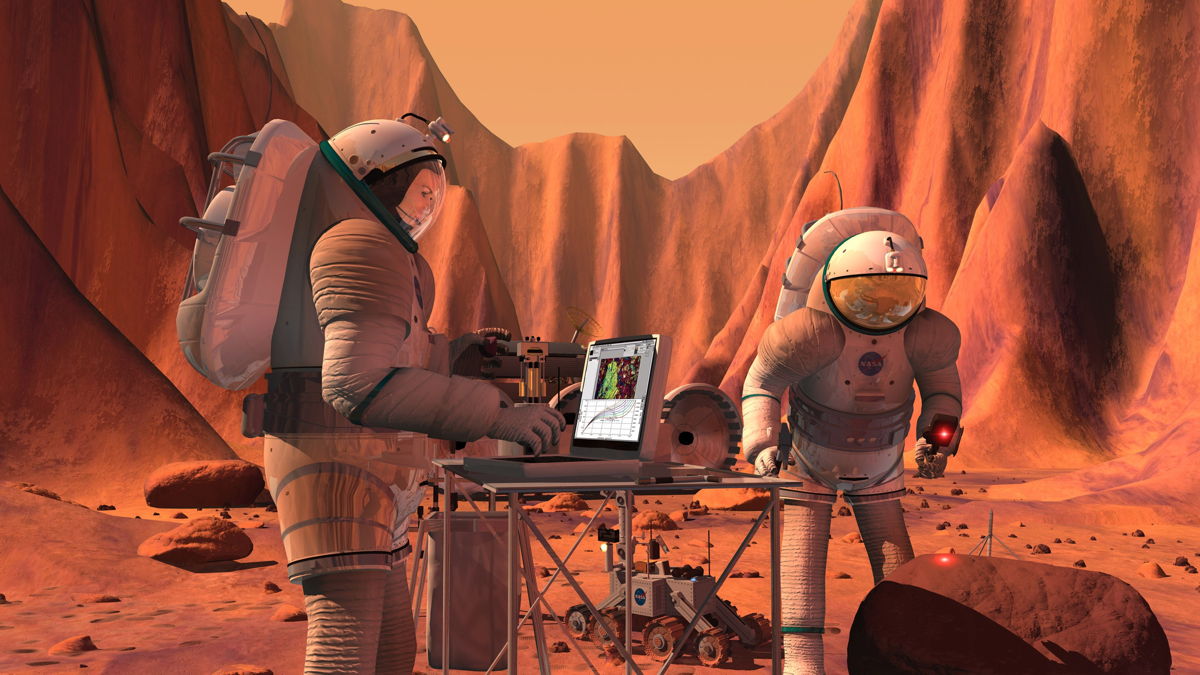Crewed Mars Mission May Require a Hard Deadline from Lawmakers, Experts Say

NASA's plans to send humans to Mars by the 2030s could depend on whether lawmakers set a clear objective and timeline for the mission, according to some of the people involved in that pursuit.
At the Humans to Mars Summit in Washington, D.C., last week (May 9 to 12), a panel of spaceflight industry members discussed some of the systems that will help humans get back to the moon and to Mars, such as habitats and deep-space transport vehicles.
NASA has a goal to send humans to Mars in the 2030s, and various initiatives are working toward that objective. Those efforts include the agency's construction of a massive rocket and human crew capsule, as well as plans to develop a "deep-space gateway" near the moon. But those steps may not congeal into a coherent human Mars program unless lawmakers step in, the panelists said. [5 Crewed Mission to Mars Ideas]
In the early 1960s, President John F. Kennedy gave NASA a clear objective: get humans to the surface of the moon by the end of the decade. That kind of clear, specific objective and timeline, laid out by lawmakers, may be what NASA needs now for its Mars plan, the panelists said.
"The human race is capable of incredible things when given a deadline. And they're capable of incredible procrastination without a deadline," said Rob Chambers, production strategy lead for NASA's Orion human space capsule at Lockheed Martin, who spoke on the panel. (Lockheed Martin is the primary contractor for Orion.) "We are closer to Mars today than we ever were to the moon in [1961] and [1962], bar none," Chambers said. "So what we need is a deadline."
Chambers was echoing comments from the other panelists, who agreed that a clear objective and timeline from Congress and the White House would be helpful, or even necessary, for getting humans to Mars. Their comments came in response to a question from the panel's moderator, Harley Thronson, a senior scientist for advanced mission concepts at NASA's Goddard Space Flight Center, who asked what they would like to hear from "the decision makers," including lawmakers and NASA leaders.
"What's your objective? When do you want to get there?" said Mike Fuller, part of Orbital ATK's business development division that's working with NASA. "Because that's going to … tell us how much we need to spend, when to spend it and what our milestones are along the way."
Get the Space.com Newsletter
Breaking space news, the latest updates on rocket launches, skywatching events and more!
But Fuller clarified that those questions are predicated on a much larger issue: whether lawmakers want NASA to pursue a sustained human presence at or near Mars, rather than an initiative like the Apollo Program, which had no long-term habitation goals. If lawmakers decide on a sustained human presence in deep space, the program needs to be protected from fluctuations in funding or mission objectives that can happen across presidential administrations, Fuller said.
"I would agree with all of that; I would state it as 'set a goal,'" added Matt Duggan, manager for exploration at Boeing. "Whatever the goal is, set the goal."
Boeing is working on various parts of a "Mars architecture" that will include all of the elements needed to get astronauts off Earth, to Mars, down to the Red Planet's surface, and back home. NASA and private companies other than Boeing also have drafted Mars architectures that may use different vehicles at certain stages of the journey or may have slightly different mission objectives, such as putting humans into orbit around Mars, as opposed to landing on its surface.
"Right now, each of these architectures kind of guesses a goal, and guesses at a time frame, and guesses at what you're doing at Mars," Duggan said. "So just set the goal — that would be immensely helpful."

Humphrey "Hoppy" Price, chief engineer of NASA's robotic Mars Exploration Program at the Jet Propulsion Laboratory (JPL), discussed some of the realistic budget needs of a human Mars mission, which were explored in great detail in a report from JPL. Price said lawmakers should create a program with a specific name, in addition to a specific objective and deadline. That program should then become "a line item on the budget," which will help ensure it carries through election cycles.
"It would need to be informed with a reasonable budget, so that it would start off at, let's say, $1 billion per year," Price said. "And it would continue going up, and at some point, it would ramp up to whatever the steady state level of that program's going to be, which — I'll just put out a number; it’s a notional number, $4 billion a year — and it's designed so that this is a line-item-funded program every year."
Earlier, Price stated that, based on JPL's expense report, if NASA's budget remains fixed, a human mission to Mars will require that the agency eventually divert funds currently used to maintain the International Space Station. NASA is committed to its current level of funding for the station through 2024. Many spaceflight industry experts agree that the station is an important part of getting humans to Mars, because it provides a training ground for astronauts and a laboratory to better understand how humans can live in deep space, as well as an opportunity for small companies to conduct scientific research in microgravity.
But Price said that, based on the current outline NASA has presented for getting humans to cislunar space (meaning orbit around the moon or regions between the moon and Earth) in the 2020s, NASA will have to remove itself from the space station in 2024. Agency representatives have said they hope the commercial sector will take over more responsibility in low Earth orbit.
"We've got to make some decisions [today] about funding and where we're putting our money," said Steve Overton, program manager for integrated space systems at Aerojet Rocketdyne. "Obviously, [NASA has] priorities. And they want to do it all. That's really hurting us. We need to focus on one thing … Tell us what you're going to focus on specifically, and let's go for that. Right now, they've got the ISS. I don't want to say that anything is not important, but obviously, NASA's got a lot of priorities going on, and they need to focus on one thing. They only have a small pot of money."
The panelists expressed confidence that NASA and its commercial partners will be capable of fulfilling whatever goal and deadline lawmakers set.
"NASA and the commercial partners have a good history of working together and being partners in the development effort," Fuller said. "Give us the guidance that we're looking for, and basically, at that point, cut us loose. Let us run."
Follow Calla Cofield @callacofield. Follow us @Spacedotcom, Facebook and Google+. Original article on Space.com.
Join our Space Forums to keep talking space on the latest missions, night sky and more! And if you have a news tip, correction or comment, let us know at: community@space.com.

Calla Cofield joined Space.com's crew in October 2014. She enjoys writing about black holes, exploding stars, ripples in space-time, science in comic books, and all the mysteries of the cosmos. Prior to joining Space.com Calla worked as a freelance writer, with her work appearing in APS News, Symmetry magazine, Scientific American, Nature News, Physics World, and others. From 2010 to 2014 she was a producer for The Physics Central Podcast. Previously, Calla worked at the American Museum of Natural History in New York City (hands down the best office building ever) and SLAC National Accelerator Laboratory in California. Calla studied physics at the University of Massachusetts, Amherst and is originally from Sandy, Utah. In 2018, Calla left Space.com to join NASA's Jet Propulsion Laboratory media team where she oversees astronomy, physics, exoplanets and the Cold Atom Lab mission. She has been underground at three of the largest particle accelerators in the world and would really like to know what the heck dark matter is. Contact Calla via: E-Mail – Twitter









